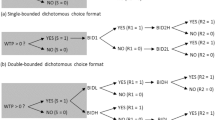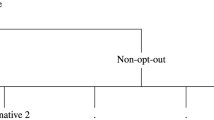Abstract
This paper has four purposes. First, we outline the controversy surroundingthe issue of negative willingness to pay (WTP)in contingent valuation (CV) studies. Second,we use Monte Carlo simulation to examine theperformance of alternative distributionalassumptions in estimating WTP in the presenceof varying proportions of the populationholding negative WTP values. We focus ondichotomous choice CV (DC-CV), where negativeWTP values may be especially difficult todetect. Third, we extend the simulation toinvestigate the performance of the mixturemodels that have recently been proposed forhandling/identifying non-positive WTP values. Fourth, we extend the simulation to investigatethe performance of the nonparametric lowerbound Turnbull approach. Results indicate thatthe relative performance of the DC-CV modelingalternatives evaluated here, which assumepositive WTP, varies across the simulationsetting (e.g., proportion of negative WTP); butnone can be said to reasonably ``solve'' theproblem ex post. This underscores theimportance of ex ante efforts to identify ifnegative WTP is likely to be prominent in agiven valuation setting. In such cases,appropriately handling negative WTP must beaddressed through ex ante survey design andmodeling choices that allow negative WTP.
Similar content being viewed by others
REFERENCES
Alberini, A. (1995), ‘Testing Willingness to Pay Models of Discrete Choice Contingent Valuation Data’, Land Economics 71, 83–95.
Bateman, I., I. Langford, K. Turner, K. Willis and G. Garrod (1995), ‘Elicitation and Truncation Effects in Contingent Valuation Studies’, Ecological Economics 12, 93–106.
Berrens, R., A. Bohara and J. Kerkvliet (1997), ‘A Randomized Response Approach to Dichotomous Choice Contingent Valuation’, American Journal of Agricultural Economics 79, 275–290.
Berrens, R., D. Brookshire, P. Ganderton and M. McKee (1998), ‘Exploring the Nonmarket Social Impacts of Environmental Policy Change’, Resource and Energy Economics 19, 117–138.
Berrens, R., P. Ganderton and C. Silva (1996), ‘Valuing the Protection of Minimum Instream Flows in New Mexico’, Journal of Agricultural and Resource Economics 21, 294–309.
Bowker, M. and J. Stoll (1988), ‘Use of Dichotomous Choice Nonmarket Methods to Value the Whooping Crane Resource’, American Journal of Agricultural Economics 70, 372–381.
Boyle, K., M. Welsh and R. Bishop (1986), ‘Validation of Empirical Measures of Welfare Change’, Land Economics 64, 94–98.
Cameron, T. and J. Englin (1997), ‘Respondent Experience and Contingent Valuation of Environmental Goods’, Journal of Environmental Economics and Management 33, 296–313.
Cameron, T. and M. James (1987), ‘Efficient Estimation Methods for Close-Ended Contingent Valuation Surveys’, Review of Economics and Statistics 69, 269–276.
Cameron, T. and J. Quiggin (1994), ‘Estimation Using Contingent Valuation Data from a “Dichotomous Choice with Follow-up” Questionnaire’, Journal of Environmental Economics and Management 27, 218–234.
Cameron, T. and J. Quiggin (1998), ‘Estimation Using Contingent Valuation Data from “Dichotomous Choice with Follow-up” Questionnaire: Reply’, Journal of Environmental Economics and Management 35, 195–199.
Carson, R. T., W. M. Hanemann, R. J. Kopp, S. Presser and P. Rund (1992), A Contingent Valuation Study of Lost Passive Use Values Resulting from the Exxon Valdez Oil Spill. Anchorage, AK: Report for the Attorney General of the State of Alaska.
Carson, R. T., W.M. Hanemann, R. J. Kopp, J. A. Krosnick, R. C. Mitchell, S. Presser, P. A. Rund, V. K. Smith, M. Conaway and K. Martin (1998), ‘AReferendum Design and Contingent Valuation: The NOAA-Panel's No-Vote Recommendation’, Review of Economics and Statistics 80, 335–338.
Castle, E. and R. Berrens (1993), ‘Economic Analysis, Endangered Species and the Safe Minimum Standard’, Northwest Environmental Journal 9, 108–130.
Castle, E., R. Berrens and R. Adams (1994), ‘Natural Resource Damage Assessment: Speculations about a Missing Perspective’, Land Economics 70, 378–385.
Chadwick, D. (1998), ‘The Return of the Grey Wolf’, National Geographic 193, 145–169.
Donaldson, C., T. Mapp, M. Ryan and K. Curtin (1996), ‘Estimating the Economic Benefits of Avoiding Food-Borne Risk: Is Willingness to Pay Feasible’, Epidemiology and Infection 116, 285–294.
Duffield, J. (1993), An Economic Analysis of Wolf Recovery in Yellowstone Park: Visitor Attitudes and Values, Department of Economics. Missoula, MT: University of Montana.
Duffield, J. and D. Patterson (1991), ‘Inference and Optimal Design for a Welfare Measure in Dichotomous Choice Contingent Valuation’, Land Economics 67, 225–239.
Ekstrand, E. and J. Loomis (1998), ‘Incorporating Respondent Uncertainty when EstimatingWillingness to Pay for Protecting Critical Habitat for Threatened and Endangered Fish’, Water Resources Research 34, 3149–3155.
Elnagheeb, A. and J. Jordan (1995), ‘Comparing Three Approaches that Generate Bids for the Referendum Contingent Valuation Method’, Journal of Environmental Economics and Management 29, 92–104.
Greene, W. (1997), Econometric Analysis, 3rd edn. Upper Saddle River, NJ: Prentice Hall.
Haab, T. and K. McConnell (1997), ‘Alternative Methods for Handling Negative Willingness to Pay in Referendum Models’, Journal of Environmental Economics and Management 32, 251–270.
Haab, T. and K. McConnell (1998), ‘Referendum Models and Economic Values: Theoretical, Intuitive, and Practical Bounds on Willingness to Pay’, Land Economics 74, 216–229.
Hanemann, W. H. and B. Kanninen (1999), ‘The Statistical Analysis of Discrete-Response CV Data’, in I. Bateman and K. Willis, eds., Valuing Environmental Preferences: Theory and Practice of the Contingent Valuation Method in the US, EC and Developing Countries. Oxford, UK: Oxford University Press.
Hausman, J., ed. (1993), Contingent Valuation: A Critical Assessment. New York: North Holland.
Hoobyar, P. (1999). ‘Tensions Rise as Fishing Resumes for Coho off Oregon Coast’, Restoration. Oregon Sea Grant Publication, Spring: 1–4. Corvallis, OR: Oregon State University.
Jakobsson, K. and A. Dragun (1996), Contingent Valuation and Endangered Species. Cheltenham, UK: Edward Elgar.
Keith, J., C. Fawson and V. Johnson (1996), ‘Preservation or Use: A Contingent Valuation Study of Wilderness Preservation in Utah’, Ecological Economics 18, 207–214.
Kristrom, B. (1997), ‘Spike Models in Contingent Valuation’, American Journal of Agricultural Economics 79, 1013–1023.
Lockwood, M., J. Loomis and T. DeLacy. (1994), ‘The Relative Unimportance of Non-market Willingness to Pay for Timber Harvesting’, Ecological Economics 9, 145–152.
Lockwood, M., P. Tracey and N. Klomp (1996), ‘Analyzing Conflict between Cultural Heritage and Nature Conservation in the Australian Alps: A CVM Approach’, Journal of Environmental Planning and Management 39, 357–370.
Loomis, J. and E. Ekstrand (1998), ‘Alternative Approaches for Incorporating Respondent Uncertainty when Estimating Willingness to Pay: The Case of the Mexican Spotted Owl’, Ecological Economics 27, 29–41.
Mathews, K. and F. R. Johnson (1999), ‘Damned if You Do and Damned if You Don't: Nonuse Stated Preferences in Salmon Preservation Policy’, Technical Working Paper #T9903. North Carolina: Triangle Economic Research.
Portney, P. (1994), ‘The Contingent Valuation Debate: Why Economists Should Care’, Journal of Economics Perspectives 8, 3–17.
Rosenthal, D. and R. Nelson (1992), ‘Why Existence Values Should Not Be Used in Cost-Benefit Analysis’, Journal of Policy Analysis and Management 11, 116–122.
Werner, M. (1999), ‘Allowing for Zeros in Dichotomous-Choice Contingent-Valuation Models’, Journal of Business and Economic Statistics 17, 479–486.
Wilson, P. (1999), ‘Wolves, Politics and the Nez Perce:Wolf Recovery in Central Idaho and the Role of Native Tribes’, Natural Resources Journal 39, 543–564.
Author information
Authors and Affiliations
Rights and permissions
About this article
Cite this article
Bohara, A.K., Kerkvliet, J. & Berrens, R.P. Addressing Negative Willingness to Pay in Dichotomous Choice Contingent Valuation. Environmental and Resource Economics 20, 173–195 (2001). https://doi.org/10.1023/A:1012642902910
Issue Date:
DOI: https://doi.org/10.1023/A:1012642902910




